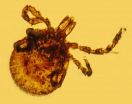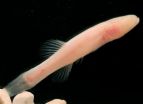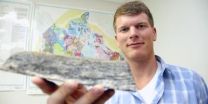(Press-News.org) War wounds that heal successfully frequently contain different microbial species from those that heal poorly, according to a paper published ahead of print in the Journal of Clinical Microbiology. These and other findings have important implications for improving wound healing, says first author Nicholas Be of Lawrence Livermore National Laboratory, Livermore, California.
The problem the researchers were addressing is that culture-based identification, which has been used to assay war wound infections, misses the many species that are difficult or impossible to culture. But Be and his collaborators posited that using microarrays and whole genome sequencing to detect microbial species in wound samples would reveal infections caused by microbes that cannot be cultured, as these molecular methods can detect all species for which reference DNA is available.
"We also hypothesized that different microorganisms could be associated with successful or unsuccessful healing, and we felt that this information could be used for guiding medical treatment," says Be.
In the study, the investigators found that genetic sequences from certain bacteria, including Pseudomonas species and Acinetobacter baumannii, were frequently observed in wounds that failed to heal, while bacteria typically associated with the gastrointestinal system, such as E. coli and Bacteroides species, were found in wounds that did heal successfully.
"This surprising finding further emphasizes the need for specific molecular detection," says Be. "We also observed via whole genome sequencing that the complex microbial populations present in wounds vary between patients and change over time in a single patient, further emphasizing the need for personalized treatment of individual wounds."
The investigators examined 124 wound samples from 61 wounds in 44 patients injured in combat in Iraq and Afghanistan. They used a microbial detection microarray developed at Lawrence Livermore National Laboratory, which contains DNA probes capable of detecting any microorganisms that have previously been sequenced.
"This represents a cost-effective, high-throughput platform for analysis of wound infections," says Be. A subset of samples was also subjected to whole genome sequencing.
"Information on the presence of specific bacteria that more significantly affect the success of the healing response could guide therapy and allow for more accurate prediction of outcome," says Be. "More effective, specific, and timely diagnosis of infection would improve treatment, accelerate rehabilitation, and decrease the length of hospital stays."
The manuscript can be found online at http://bit.ly/asmtip0514i. The final version of the article is scheduled for the July 2014 issue of the Journal of Clinical Microbiology.
INFORMATION:
Journal of Clinical Microbiology is a publication of the American Society for Microbiology (ASM). The ASM is the largest single life science society, composed of over 39,000 scientists and health professionals. Its mission is to advance the microbiological sciences as a vehicle for understanding life processes and to apply and communicate this knowledge for the improvement of health and environmental and economic well-being worldwide.
Improved identification of war wound infections promises more successful treatment
2014-05-29
ELSE PRESS RELEASES FROM THIS DATE:
Huge tooth fossil shows marine predator had plenty to chew on
2014-05-29
A fossilised tooth belonging to a fearsome marine predator has been recorded as the largest of its kind found in the UK, following its recent discovery.
A team of palaeontologists have verified the tooth, which was found near Chesil Beach in Dorset, as belonging to a prehistoric relative of modern crocodiles known as Dakosaurus maximus.
The tooth, which has a broken tip, is approximately 5.5 cm long.
Researchers and curators from University of Edinburgh and the Natural History Museum in London identified the item after it was bought at an online auction by a fossil ...
Amber discovery indicates Lyme disease is older than human race
2014-05-29
CORVALLIS, Ore. – Lyme disease is a stealthy, often misdiagnosed disease that was only recognized about 40 years ago, but new discoveries of ticks fossilized in amber show that the bacteria which cause it may have been lurking around for 15 million years – long before any humans walked on Earth.
The findings were made by researchers from Oregon State University, who studied 15-20 million-year-old amber from the Dominican Republic that offer the oldest fossil evidence ever found of Borrelia, a type of spirochete-like bacteria that to this day causes Lyme disease. They ...
Remember parathyroid hormone as well as vitamin D to assess vitamin's role in diabetes
2014-05-29
TORONTO -- Combined assessment of parathyroid hormone along with vitamin D may be needed to assess the impact of vitamin D status on sugar metabolism, according to Toronto researchers. Their study is published on-line in Diabetes on May 29 2014.
The new findings might explain why studies of vitamin D alone have been conflicting and why clinical trials of vitamin D supplementation to improve diabetes have been disappointing, says principal investigator Dr. Ravi Retnakaran. He is a clinician-scientist at the Lunenfeld-Tanenbaum Research Institute at Mount Sinai Hospital ...
Grape-enriched diet supports eye health
2014-05-29
FRESNO, CA – New research presented this week at the Association for Research in Vision and Ophthalmology conference in Orlando, Florida suggests that regular grape consumption may play a role in eye health by protecting the retina from deterioration. Specifically, a grape-enriched diet resulted in a protective effect on retinal structure and function.
The retina is the part of the eye that contains the cells that respond to light, known as photoreceptors. There are two types of photoreceptors: rods and cones. Retinal degenerative diseases affect over 5 million people ...
First-of-its-kind study: Swimmers gain an advantage when they recover with chocolate milk
2014-05-29
Grabbing chocolate milk after a hard swim could give swimmers a performance edge, according to new research presented at one of the nation's top sports medicine conferences – the American College of Sports Medicine's annual conference.1 In a sport where seconds and even tenths of a second can make a big difference and intense practice routines are the norm, Indiana University researchers found that when collegiate, trained swimmers recovered with chocolate milk after an exhaustive swim, they swam faster in time trials later that same day. On average, they shaved off 2.1 ...
The Hoosier Cavefish, a new and endangered species from the caves of southern Indiana
2014-05-29
A new eyeless cavefish is described from Indiana and named after the Indiana Hoosiers. It is the first new cavefish species described from the U.S. in 40 years. Notably, it has an anus right behind its head, and the females brood their young in their gill chamber. The new species was described in the open access journal ZooKeys.
The new species, Amblyopsis hoosieri, is the closest relative of a species (A. spelaea) from the longest cave system in the world, Mammoth Cave in Kentucky. These two species are separated by the Ohio River, which also separates the states of ...
Think fast, robot
2014-05-29
One of the reasons we don't yet have self-driving cars and mini-helicopters delivering online purchases is that autonomous vehicles tend not to perform well under pressure. A system that can flawlessly parallel park at 5 mph may have trouble avoiding obstacles at 35 mph.
Part of the problem is the time it takes to produce and interpret camera data. An autonomous vehicle using a standard camera to monitor its surroundings might take about a fifth of a second to update its location. That's good enough for normal operating conditions but not nearly fast enough to handle ...
Minority entrepreneurs face discrimination when seeking loans
2014-05-29
A disheartening new study from researchers at Utah State University, BYU and Rutgers University reveals that discrimination is still tainting the American Dream for minorities.
The three-part research article, which appears online in the Journal of Consumer Research, finds that minorities seeking small business loans are treated differently than their white counterparts, despite having identical qualifications on paper.
While discrimination in housing, employment and education is well documented, the study shows that minorities also face discrimination in the marketplace. ...
Four-billion-year-old rocks yield clues about Earth's earliest crust
2014-05-29
(Edmonton) It looks like just another rock, but what Jesse Reimink holds in his hands is a four-billion-year-old chunk of an ancient protocontinent that holds clues about how the Earth's first continents formed.
The University of Alberta geochemistry student spent the better part of three years collecting and studying ancient rock samples from the Acasta Gneiss Complex in the Northwest Territories, part of his PhD research to understand the environment in which they formed.
"The timing and mode of continental crust formation throughout Earth's history is a controversial ...
Diesel bus alternative
2014-05-29
Electric school buses that feed the power grid could save school districts millions of dollars — and reduce children's exposure to diesel fumes — based on recent research by the University of Delaware's College of Earth, Ocean, and Environment (CEOE).
A new study examines the cost-effectiveness of electric school buses that discharge their batteries into the electrical grid when not in use and get paid for the service. The technology, called vehicle-to-grid (V2G), was pioneered at UD and is being tested with electric cars in a pilot project.
Adapting the system for ...




